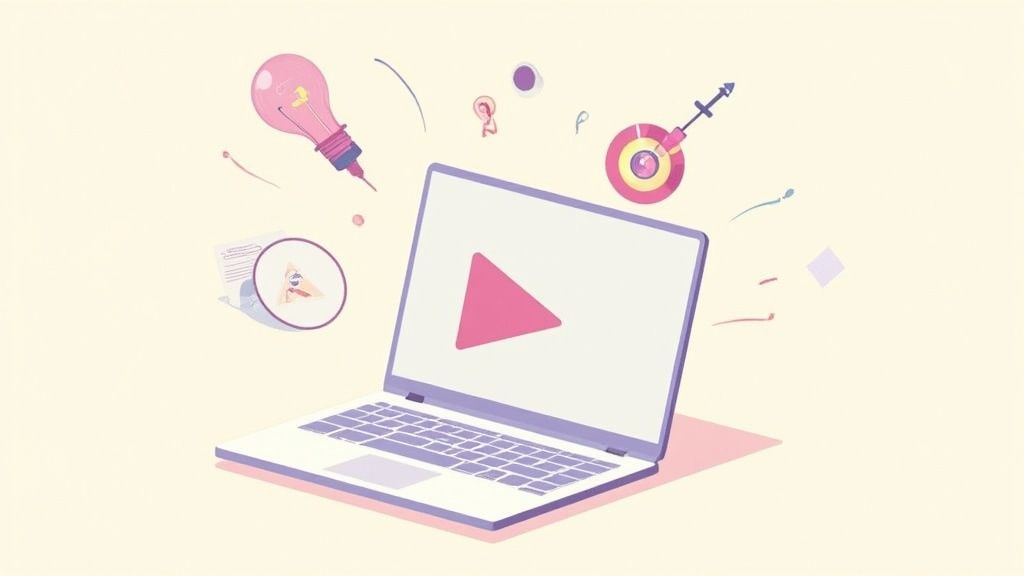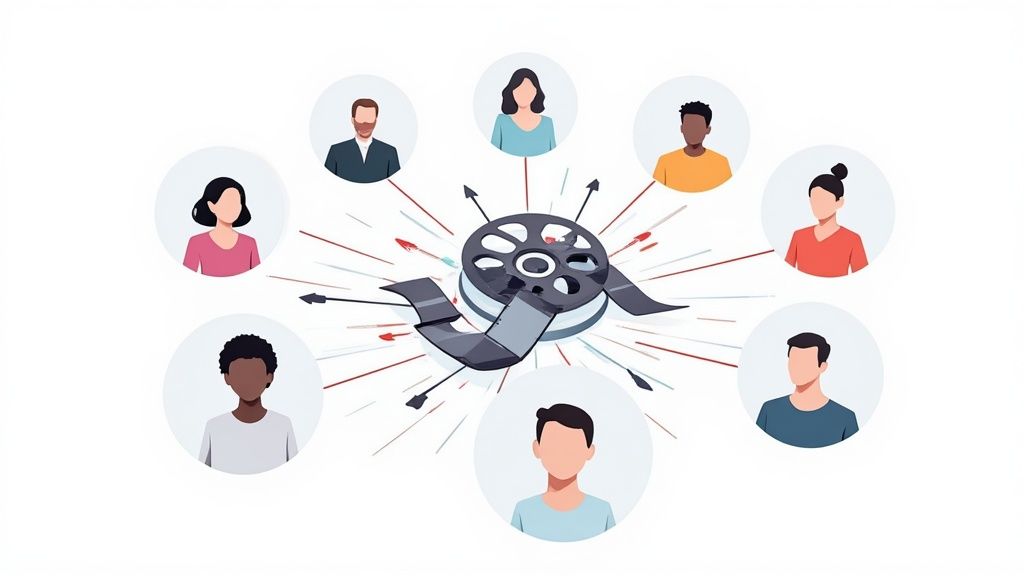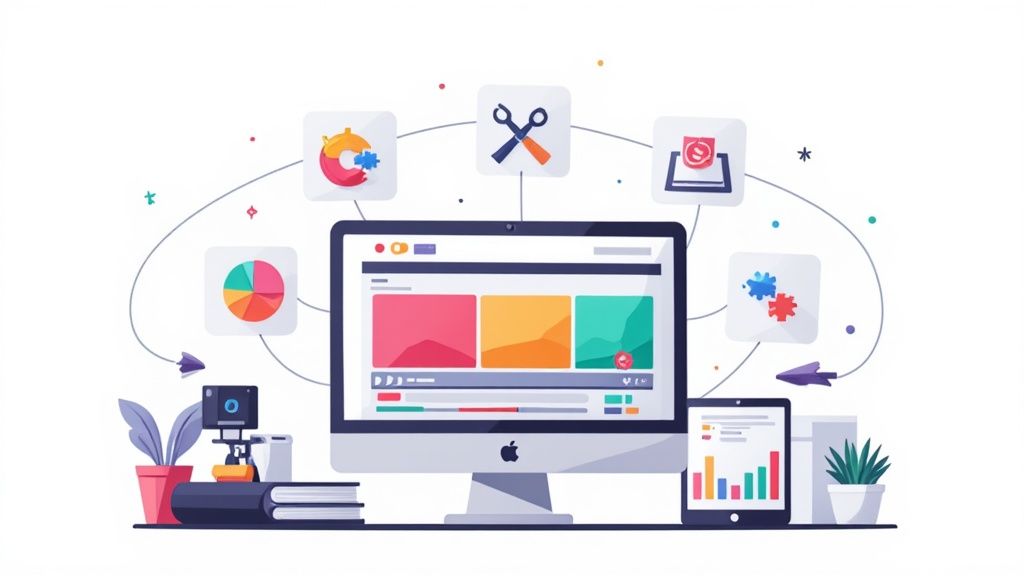5 Proven Storytelling Techniques That Trigger Virality in 2025


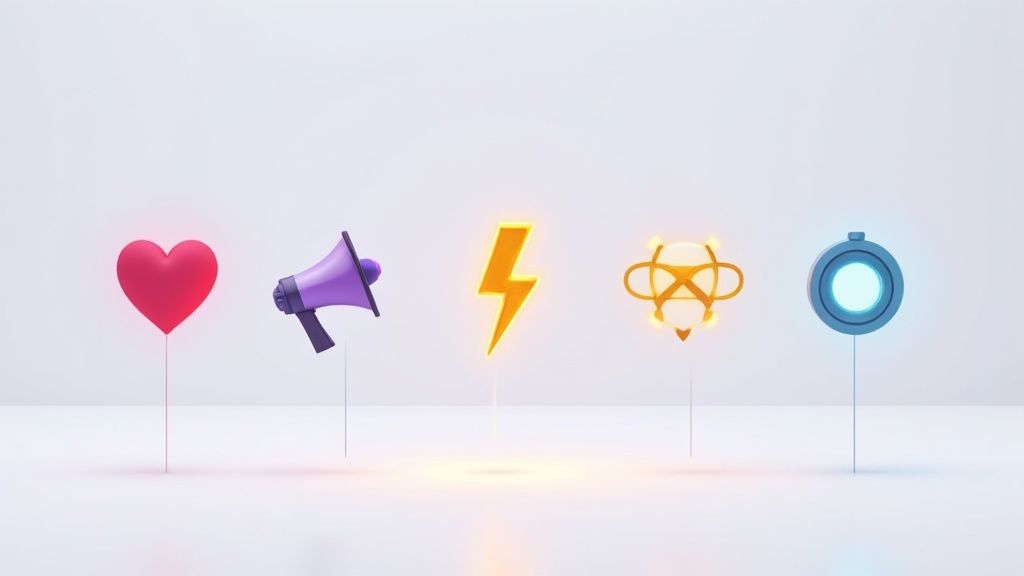
A single story can change everything. One viral video transformed Dollar Shave Club from an unknown startup into a billion-dollar acquisition target. A single, perfectly crafted tweet can generate more brand awareness than a multi-million dollar ad campaign. This raises the critical question for every marketer, founder, and creative director: Is virality just a matter of luck, or is it a science that can be engineered?
While there's no guaranteed formula for a viral hit, the answer isn't pure chance. The most successful content, the kind that people feel compelled to share, consistently leverages specific narrative structures. These aren't random; they are deeply rooted in the psychology of human connection, emotional response, and the desire for social currency. When a story makes us feel something powerful, gives us a new perspective, or helps us define who we are, we are biologically wired to pass it on.
This article decodes that process. We will dissect 5 Proven Storytelling Techniques That Trigger Virality, moving beyond abstract theory into actionable frameworks. You won’t find generic advice here. Instead, you'll get a detailed breakdown of each technique, from "The Hero's Journey with a Twist" to "Pattern Interruption with Insight," complete with practical examples and implementation steps. These are the replicable methods used by leading brands and creators to consistently produce content that spreads. For businesses aiming to harness these high-impact creative strategies without building a massive in-house team, understanding these fundamentals is the first step toward creating content that truly connects and scales. Let's dive in.
1. The Hero's Journey with a Twist
We are all fundamentally wired to love a good hero story. It’s a pattern we recognize instantly: a protagonist is called to an adventure, faces trials, and returns transformed. This framework, famously outlined by Joseph Campbell, is the backbone of countless myths, movies, and legends. However, in a saturated digital world, the classic formula alone isn't enough to capture attention. This is where the twist comes in, making it one of the most potent storytelling techniques that trigger virality.
The "Hero's Journey with a Twist" takes our ingrained expectations of this narrative and flips them on their head. Instead of a gallant knight slaying a dragon, the hero might be an everyday person disrupting a stale industry, a controversial figure redefining courage, or even the audience member discovering their own power. This subversion creates a powerful combination of familiarity and surprise, compelling viewers to not only watch but to share and discuss what they’ve just seen.
The magic happens when the audience thinks they know where the story is going, only to be presented with a clever reversal that reinforces the core message in an unforgettable way.
How It Works: Familiarity Meets Surprise
This technique leverages a psychological principle known as schema theory. Our brains create mental shortcuts (schemas) to understand the world, and the Hero's Journey is a powerful storytelling schema. When you introduce a narrative that starts along this familiar path, you lower the cognitive load for the audience; they feel comfortable and engaged.
The "twist" then intentionally violates this schema. This violation creates a moment of cognitive dissonance, a jolt of surprise that forces the brain to pay closer attention and re-evaluate what it's seeing. This moment is what makes the content memorable and highly shareable. People share things that surprise them, challenge their assumptions, or give them a new perspective on a familiar idea.
Key Insight: The goal isn’t just shock value. The twist must be meaningful and serve the brand's core message. It should reframe the problem or the solution in a way that feels both unexpected and inevitable in hindsight.
Real-World Examples of a Twisted Journey
- Dollar Shave Club: The protagonist isn't a chiseled model but the company's founder, a regular guy named Mike. His "quest" isn't to save a kingdom but to save men from overpriced razors. The enemy isn't a monster; it's the established grooming industry. The deadpan humor and direct-to-camera delivery subverted every polished, self-serious razor commercial that came before it, turning a simple product launch into a viral phenomenon.
- Nike's "Dream Crazy" with Colin Kaepernick: Nike cast an athlete, a traditional hero figure, but one who was deeply controversial. His "heroic act" wasn't winning a game but sacrificing his career for his beliefs. This reframed the definition of a sports hero from one of physical prowess to one of moral conviction, sparking intense debate and making the campaign impossible to ignore.
- Old Spice's "The Man Your Man Could Smell Like": This campaign turned the hero concept into pure, delightful absurdity. The protagonist is an impossibly suave, charismatic man who seamlessly transitions from a shower to a boat to riding a horse (backwards). The "journey" is a rapid-fire series of surreal events, and the twist is that this ideal hero is attainable through a simple bottle of body wash. It subverted the very idea of a male grooming ad, making it hilariously shareable.
For more inspiration on how brands effectively use storytelling, you can explore some of the best brand story examples here.
Actionable Steps for Implementation
To apply this powerful technique to your own content, follow these strategic steps:
- Identify a Relatable Protagonist: Start with a hero your audience can see themselves in. This could be a customer archetype, an employee, or even the founder. The more relatable the starting point, the more impactful the transformation.
- Define a Common "Dragon": What is the everyday frustration, challenge, or injustice your audience faces? This is your villain. It doesn’t need to be epic; it just needs to be real (e.g., boring meetings, complex software, high prices).
- Build the "Call to Adventure": Show the moment the protagonist decides they've had enough of the status quo. This is where your brand or product enters the story as the "magic sword" or "wise mentor" that enables their quest.
- Engineer the Twist: This is the critical step. How can you subvert expectations?
- Role Reversal: Make the customer the hero, not the brand.
- Tone Subversion: Tackle a serious topic with humor, or a mundane topic with epic grandeur.
- Outcome Inversion: Show that "winning" looks different than what the audience expects.
- Showcase the Transformation: End with a clear picture of the "new world" your hero now lives in thanks to their journey. This final state should be aspirational and something your audience wants for themselves, providing the emotional payoff that drives shares.
2. The Cliffhanger Loop
Have you ever finished a TV show episode and immediately needed to watch the next one? Or scrolled through TikTok and found yourself watching a "Part 2" you didn't even know you were waiting for? That irresistible pull is the power of the cliffhanger, a technique that has been supercharged for the digital age into what we call the Cliffhanger Loop. It is undeniably one of the most effective storytelling techniques that trigger virality.
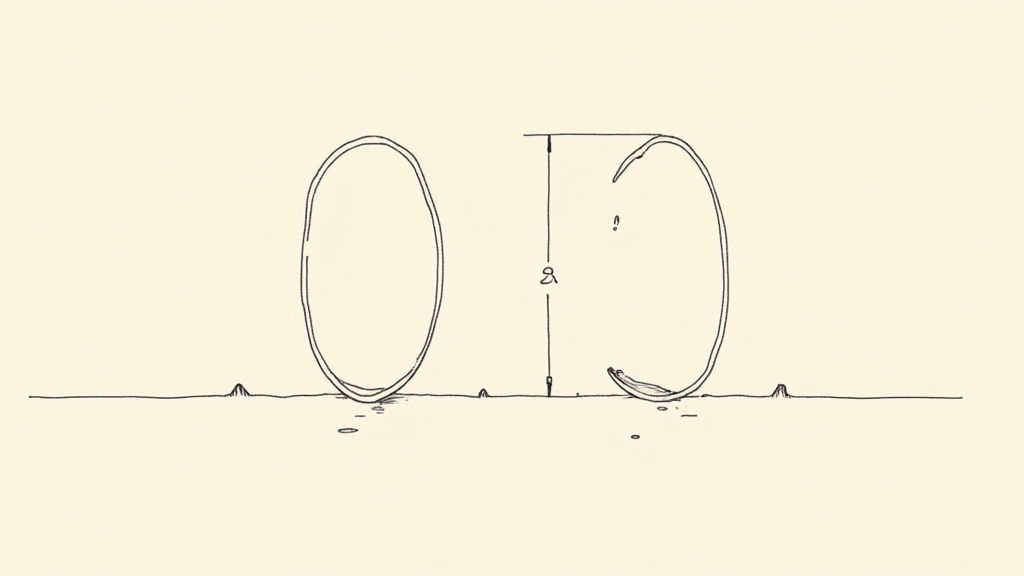
The Cliffhanger Loop operates by intentionally withholding crucial information or delaying a resolution. It presents a story, poses a question, or builds intense suspense, and then stops just before the payoff. This creates a powerful urge for closure, compelling audiences to take action: follow the account, check the comments for answers, or share the content to see what others think. It transforms passive viewing into active participation.
This method turns a single piece of content into a self-perpetuating cycle of engagement, where the anticipation for "what happens next" becomes the primary driver of likes, comments, and shares.
How It Works: The Psychology of Unfinished Business
This technique masterfully exploits two powerful psychological principles: the curiosity gap and the Zeigarnik effect. The curiosity gap, a term coined by George Loewenstein, suggests that curiosity arises when there is a gap between what we know and what we want to know. A cliffhanger creates this gap, making our brains desperate to fill it.
The Zeigarnik effect is the tendency to remember uncompleted or interrupted tasks better than completed ones. An unresolved story creates mental tension. To relieve this tension, our minds push us to seek resolution. In the context of social media, this translates directly into engagement metrics as users seek out the next part of the story.
Key Insight: The goal is not to frustrate your audience, but to create a compelling sense of anticipation. A successful cliffhanger promises a satisfying resolution and makes the audience feel like they are part of an unfolding event, not just the recipient of an ad.
Real-World Examples of the Cliffhanger Loop
- TikTok 'Part 1 of 3' Series: Creators on TikTok have mastered this. They will start a story at its most dramatic point, then cut the video with a "like and follow for Part 2" prompt. Storytellers sharing dramatic personal events or creators testing a popular hack use this to build a massive following almost overnight, as each video in the series goes viral from viewers needing to see the conclusion.
- Marvel's Post-Credit Scenes: Marvel Studios has institutionalized the cliffhanger. Every film ends, but the post-credit scene introduces a new character, a new threat, or a shocking twist. This small snippet of story is designed to create years of speculation and ensures audiences are already hyped for the next installment before they even leave the theater.
- True Crime Podcasts like 'Serial': The first season of 'Serial' became a cultural phenomenon by releasing its investigation into a real-life murder case week by week. Each episode revealed new evidence but ended on a note of uncertainty, leaving millions of listeners to debate theories online and eagerly await the next drop. The suspense was the product.
- Tesla's Product Reveals: Elon Musk is a master of the corporate cliffhanger. He uses cryptic tweets and staged events to build immense hype for new products. The reveal of the Cybertruck, complete with the "unbreakable" glass shattering, created an unresolved narrative: Is it a failure or a brilliant marketing stunt? This uncertainty fueled global conversation for weeks.
For an even deeper understanding of how to build suspense visually, you can explore these compelling examples of visual storytelling.
Actionable Steps for Implementation
To build your own engagement engine with the Cliffhanger Loop, follow these steps:
- Open with Intrigue: Don't save the best for last. Start your story at the moment of highest tension or with the most burning question. Then, you can rewind to explain how you got there.
- Create Genuine Stakes: The audience must care about the outcome. Whether it's a personal challenge, a business problem, or a social experiment, the stakes need to feel significant and relatable to your target viewers.
- Signal What's Coming: Be explicit. Use text overlays like "Wait for it..." or "Part 1," or audio cues that signal more is on the way. This manages expectations and gives a clear call to action (follow, stay tuned).
- Pace Your Revelations: If you're creating a series, don't save everything for the final part. Each installment should offer a partial resolution while simultaneously opening up a new question. This maintains momentum without causing audience fatigue.
- Always Deliver the Payoff: This is crucial for long-term trust. The resolution must be as satisfying as the setup was intriguing. Failing to deliver on your promise will break audience trust and make this technique ineffective in the future.
3. Emotional Polarization
In a world of infinite content, neutrality is the enemy of virality. Content that is merely "nice" or "interesting" is easily scrolled past and forgotten. Emotional Polarization is a daring storytelling technique that intentionally creates a strong, divisive emotional response. It’s designed to be loved by some and vehemently disliked by others, eliminating the lukewarm middle ground where content goes to die.
This approach works because high-arousal emotions, both positive (awe, joy, inspiration) and negative (anger, outrage, frustration), are powerful catalysts for sharing. When a story taps into deeply held values, beliefs, or identities, it compels people to react, comment, and share it as a form of self-expression or social signaling. By taking a firm stance on a meaningful issue, this becomes one of the boldest storytelling techniques that trigger virality.

The goal isn't to be controversial for its own sake, but to create a narrative so aligned with a specific worldview that it galvanizes a core audience into becoming passionate advocates. This creates a "for us, by us" feeling that is incredibly powerful.
How It Works: High Arousal and Identity Signaling
This technique taps into the Social Identity Theory, which suggests that people's sense of self is tied to the groups they belong to. When a piece of content affirms or challenges the values of that group, it triggers a strong emotional and psychological response. This isn't just a story; it's a statement about who we are.
Sharing this type of content becomes an act of identity signaling. When you share a story that polarizes, you are publicly aligning yourself with one side of the debate. This high-arousal state, whether fueled by righteous anger or profound inspiration, bypasses our passive consumption habits and activates our impulse to engage. The resulting conversation, debate, and defense of the content is what fuels its viral spread.
Key Insight: True polarization isn't about creating fake outrage. It's about having the courage to plant a flag on a value your brand genuinely believes in, knowing that it will attract your true tribe while repelling those who don't align. The risk is high, but the potential for loyalty is immense.
Real-World Examples of Emotional Polarization
- Gillette's "The Best Men Can Be": This ad tackled toxic masculinity head-on, directly challenging traditional portrayals of manhood. It was praised by many for its progressive message but condemned by others who felt it was an attack on men. The intense debate generated hundreds of millions of views and made Gillette the center of a global conversation, for better or worse.
- Patagonia's "Don't Buy This Jacket": On Black Friday, the biggest shopping day of the year, Patagonia ran an ad telling people not to buy their products. This anti-consumerist message strongly resonated with their eco-conscious base, turning them into passionate brand evangelists. It alienated anyone looking for a simple holiday discount but cemented Patagonia's identity as a mission-driven company.
- Cards Against Humanity: The entire brand is built on a foundation of provocative, polarizing humor. Their marketing stunts, like digging a pointless hole for Black Friday or selling literal bull feces, are designed to delight their cynical, irreverent audience while likely offending many others. This unwavering commitment to a specific brand of humor has built a cult-like following.
Actionable Steps for Implementation
To strategically leverage emotional polarization, proceed with careful planning:
- Identify Your Core, Unshakeable Value: What is a principle your brand is willing to stand for, even if it means losing some customers? This must be authentic and deeply integrated into your company's DNA. Examples include sustainability, social justice, free speech, or radical transparency.
- Understand Your Audience's Passions: Research what truly drives your target audience. What issues do they care about deeply? The polarizing story must connect with a pre-existing passion point to be effective.
- Craft a Narrative with a Clear Stance: Don't hedge your bets. Your story must present a clear point of view. Frame it as "We believe X," which implicitly means "We don't believe Y." This clarity is what creates the division.
- Prepare for the Backlash: You cannot use this technique without anticipating and planning for negative reactions. Prepare your social media and PR teams with responses. Decide which criticisms are valid and which are simply noise from an audience you were never trying to reach.
- Amplify Your Advocates: When the positive response comes, pour fuel on it. Highlight, share, and engage with the users who are passionately defending and celebrating your message. Turn your supporters into your story's biggest distributors.
For more inspiration on building campaigns around core values, explore these diverse content marketing ideas.
4. The Underdog Victory Arc
Everyone loves to root for the little guy. The Underdog Victory Arc is a powerful narrative that follows a seemingly disadvantaged protagonist who overcomes insurmountable odds to achieve a surprising and deeply satisfying victory. This technique taps into universal human emotions like hope, justice, and the belief that determination can triumph over circumstance, making it one of the most resonant and shareable storytelling techniques that trigger virality.

From David vs. Goliath to every Cinderella story in sports, we are wired to connect with those who face adversity with courage and grit. When a brand or individual embodies this spirit, they don't just sell a product; they rally a community. Audiences see their own struggles and aspirations reflected in the underdog's journey, creating an intense emotional bond that compels them to share the story as a source of inspiration.
The power of this arc lies in its inherent drama and relatability. It’s a story that says, "They did it, and maybe I can too."
How It Works: Relatability Forged Through Struggle
This technique leverages the psychological principle of empathetic joy, also known as freudenfreude. We feel genuine pleasure in witnessing the success of others, especially when we feel they have earned it through hardship. The Underdog Victory Arc is structured to maximize this emotional payoff.
By clearly establishing the protagonist's disadvantages and the towering strength of their opponent or obstacle, you create a powerful tension. The audience becomes emotionally invested in the struggle. Every small step forward feels like a monumental win. When the final victory is achieved, the release of that tension creates a potent emotional high for the viewer, making the experience memorable and inspiring them to share that positive feeling with others.
Key Insight: Authenticity is non-negotiable. The audience must believe the struggle is real and the odds are genuinely stacked against the protagonist. The victory cannot feel cheap or unearned; it must be the direct result of grit, cleverness, or unwavering belief.
Real-World Examples of Underdog Victories
- Airbnb's Origin Story: The narrative of Brian Chesky and Joe Gebbia renting out air mattresses in their apartment to make rent is legendary. Their "startup fuel" wasn't venture capital; it was selling novelty breakfast cereals named "Obama O's" and "Cap'n McCain's." This humble, scrappy beginning frames them as the ultimate underdogs against the giant hotel industry, making their eventual global success an inspiring tale of ingenuity.
- Wendy's on Twitter: While a large corporation, Wendy's social media persona is that of a plucky, witty underdog taking on giants like McDonald's and Burger King. Their now-famous Twitter roasts and sassy comebacks created a personality that consumers could rally behind. They weren't just a fast-food chain; they were the clever challenger speaking truth to power, earning them millions of shares and massive cultural relevance.
- Leicester City's Premier League Win: In 2016, Leicester City Football Club, with 5000-to-1 odds against them, won the English Premier League. Their social media content didn't just report scores; it chronicled a miracle. It showcased the team's grit, the fans' disbelief and joy, and the sheer improbability of it all. This story transcended sports, becoming a global symbol of hope that anything is possible.
For brands looking to craft their own compelling narratives, you can see more examples of how to bring these stories to life in advertising by exploring powerful storytelling ads here.
Actionable Steps for Implementation
To harness the power of the underdog for your brand, follow these strategic steps:
- Establish the "Goliath": Clearly define the giant your brand is up against. This could be a dominant competitor, an outdated industry standard, a complex problem, or a pervasive societal belief. Make the obstacle feel imposing.
- Showcase Your Disadvantage: Be transparent about your humble beginnings or limited resources. Did you start in a garage? Did experts say your idea would fail? Highlighting these disadvantages makes your journey more relatable and your eventual success more impressive.
- Chronicle the Struggle (Don't Hide It): The power is in the process. Show the late nights, the failed attempts, the moments of doubt. Share behind-the-scenes content that reveals the hard work. This builds authenticity and emotional investment.
- Highlight Your "Slingshot": What is your unique advantage? It’s not money or power, but something else: superior wit, a clever innovation, a deeper connection to the customer, or sheer persistence. This is the tool that allows the underdog to win.
- Frame the Victory as a Shared Triumph: The final victory shouldn't just be for the brand; it should be for every customer who believed in you. Position your success as a win for the community that supported you, making them feel like part of the journey and giving them a reason to celebrate and share.
5. Pattern Interruption with Insight
Our brains are masterful prediction machines, constantly scanning for patterns to conserve energy. When we scroll through a social feed or browse the web, we automatically filter out the expected: the generic ad, the predictable testimonial, the standard corporate update. To break through this filter, you must first break the pattern. This is the essence of "Pattern Interruption with Insight," one of the most effective storytelling techniques that trigger virality.
This technique works by first shattering a familiar convention or expectation, instantly grabbing the audience's attention. But it doesn't stop there. The true power lies in the second step: delivering a valuable insight or an "aha!" moment that justifies the initial disruption. This combination of shock and substance creates a powerful emotional and intellectual response, compelling people to share the newfound perspective.
It’s not just about being weird or different for its own sake. The interruption must serve a purpose, leading the audience to a meaningful conclusion that is intrinsically linked to your brand's message.
How It Works: Violate Expectations, Then Deliver Value
This method leverages the brain's orienting response, an involuntary reflex to novel stimuli. When you present something unexpected, like a blender pulverizing an iPhone, you hijack the audience's attention. Their brain temporarily halts its automatic processing and asks, "What is going on here?"
Once you have their undivided attention, you have a brief window to deliver your core message. The insight that follows the interruption acts as the reward for their attention. It might be a new way of thinking about a problem, an unexpected benefit of a product, or a powerful emotional truth. This payoff turns a simple disruption into a memorable and shareable experience. The audience shares it not just because it was surprising, but because the surprise led to genuine value.
Key Insight: The interruption earns you the audience's attention; the insight earns you their respect and their share. The two elements must work in harmony, with the break in pattern setting the stage for a powerful and relevant revelation.
Real-World Examples of Insightful Interruptions
- Blendtec's "Will It Blend?": The pattern being interrupted here is the boring, conventional product demo. Instead of showing the blender making a smoothie, founder Tom Dickson nonchalantly drops an iPhone, golf balls, and even an Amazon Echo into the machine and pulverizes them. The interruption is the shocking destruction of valuable items. The insight? If this blender can destroy an iPhone, it can certainly handle your frozen strawberries. It's an absurdly powerful demonstration of product quality.
- Always' "#LikeAGirl": This campaign interrupted a deeply ingrained social pattern: the use of "like a girl" as an insult. The video starts by asking adults and a young boy to run and fight "like a girl," and they respond with flailing, weak motions. The pattern is then shattered when young girls are asked the same question, and they respond with strength, speed, and confidence. The insight is a powerful reframing of the phrase, transforming it from an insult into a statement of empowerment.
- Volvo's "Epic Split": The typical truck commercial shows a rig hauling heavy loads on a highway. Volvo interrupted this pattern by having Jean-Claude Van Damme perform a perfect split between two reversing Volvo trucks. The visual is stunning and completely unexpected. The insight, delivered subtly, is the incredible precision and stability of Volvo's dynamic steering system, a technical feature made emotionally resonant through a breathtaking stunt. You can explore more examples of this in practice by checking out these creative video ads.
Actionable Steps for Implementation
To harness the power of pattern interruption for your own content, follow these steps:
- Identify a Dominant Pattern: What are the clichés, conventions, or "rules" in your industry's marketing? What does your audience expect to see from a brand like yours? Make a list of these predictable patterns.
- Brainstorm Ways to Break It: How can you do the complete opposite? If everyone uses polished, professional videos, try something raw and unscripted. If competitors talk about features, create a story that ignores features entirely and focuses on an emotional outcome.
- Find the Inherent Insight: Your interruption must connect back to your brand's value. Ask yourself: "What truth does this disruption reveal about our product, our mission, or our customer?" The Blendtec interruption reveals product strength; the Always interruption reveals brand values.
- Craft the "Aha!" Moment: Structure your story so the interruption creates a question in the viewer's mind ("Why are they doing this?"). Then, answer that question with your insight, creating a satisfying and memorable resolution.
- Connect It to Your Brand Message: Ensure the final takeaway reinforces what you want the audience to remember about you. The pattern break should not overshadow your brand; it should illuminate it in a new and unforgettable light.
5 Proven Storytelling Techniques Comparison
From Storytelling to Success: Your Viral Playbook
We've journeyed through the architecture of viral narratives, deconstructing the very mechanics that transform a simple story into a cultural phenomenon. From the relatable struggle of the Hero's Journey with a Twist to the insatiable curiosity sparked by The Cliffhanger Loop, these aren't just creative suggestions; they are strategic frameworks. The power of Emotional Polarization forces a stance, the Underdog Victory Arc taps into our collective desire for justice, and Pattern Interruption with Insight shatters expectations to deliver profound value.
These five proven storytelling techniques are more than isolated tactics. They represent a comprehensive toolkit for engineering virality. The common thread woven through each is the deliberate creation of an emotional, memorable experience. It’s about crafting a narrative so compelling, so resonant, that audiences don't just consume it; they feel an undeniable urge to share it, to make it part of their own identity and conversations. Virality is rarely an accident. It is the calculated result of understanding human psychology and leveraging narrative structures that speak directly to our core drivers: hope, curiosity, validation, and surprise.
Turning Theory into Tangible Results
The critical takeaway is that you now possess the blueprints. The next step is to move from passive understanding to active implementation. Don't feel pressured to master all five techniques at once. The most effective approach is to focus your efforts and execute flawlessly.
Consider your immediate marketing objectives and your brand's authentic voice.
Choose the one technique that resonates most powerfully with your current goals. Begin brainstorming, not just about the story you want to tell, but about the feeling you want to evoke. What emotional response will compel someone to click "share"? Answering this question is the first step toward creating content that doesn't just get seen but gets remembered and distributed.
Your Next Step: From Blueprint to Broadcast
Mastering the art of storytelling is one part of the equation; understanding the broader digital ecosystem is the other. To ensure your meticulously crafted narrative achieves its maximum potential, it's crucial to align your story with proven distribution principles. For a deeper exploration of this, we recommend these expert tips on how to create viral content, which provide a valuable layer of strategic thinking to complement your creative execution.
Ultimately, leveraging these 5 proven storytelling techniques that trigger virality is about more than just a fleeting spike in views. It's about forging a genuine connection with your audience. When you tell a story that makes someone feel seen, understood, or inspired, you do more than capture their attention for a moment. You begin to build a foundation of trust and loyalty that transcends any single campaign. You transform passive viewers into active brand advocates. This is the enduring power of strategic storytelling, a force capable of not only launching your message into the stratosphere but also driving sustainable, meaningful growth for your brand.
Ready to turn your viral story idea into a professionally executed masterpiece? Moonb provides the on-demand creative team you need, from scriptwriters and animators to editors, to bring your vision to life without the friction. Book a demo with Moonb today and see how easy it is to scale your creative production.



